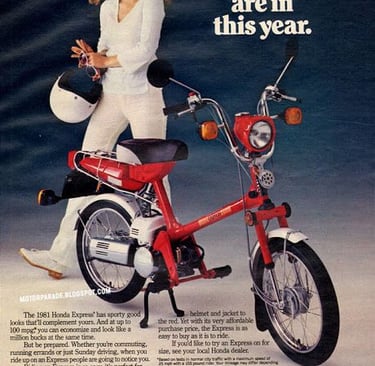The Honda Express Moped: Navigating the Streets with Style and Efficiency
The Honda Express Moped, introduced in 1977, was a fuel-efficient scooter designed for simplicity and ease of use. It had various models with different features and improvements, such as automatic transmission, self-mixing oil and fuel system, and upgrades like capacitive discharge ignition and electric start. The series concluded in North America in 1983 and in the UK in 1984, but its legacy lives on as an iconic moped.
JAPAN TWO STROKE1970'SHONDA NOPEDS
12/19/20232 min read


The Honda Express Moped: Navigating the Streets with Style and Efficiency
Introduction: In response to the growing demand for fuel-efficient transportation in the wake of the 1973 oil crisis, Honda Motor Company introduced the Honda Express (NC50) to the North American market in 1977. This innovative scooter was designed to cater to a broad audience, particularly those seeking simplicity in operation and maintenance. With its fully automatic transmission and a unique self-mixing oil and fuel system, the Honda Express quickly became a staple in the world of mopeds.
Models:
1. NC50 (1977-1983): The NC50, often referred to as a "noped" due to its lack of pedals, featured a 49cc air-cooled, oil-injected two-stroke engine. Early versions (1977-1980) boasted a manual choke, points ignition, and a distinctive spring start system. Later models (1981 onwards) incorporated capacitor discharge ignition, automatic choke, and a conventional kick-start mechanism. A facelift in 1982 introduced a new body design and a two-speed automatic transmission, enhancing both performance and aesthetics.
2. NA50 (1977-1981): Released in 1979 and produced until 1981, the NA50, or Express II, featured a modified frame, a more comfortable seat, tree handlebars, and a slightly larger gas tank compared to the NC50. In its final year, the NA50 received upgrades similar to the NC50, including CDI, auto choke, kick start, and a two-speed automatic transmission.
3. NX50 (1981-1983): Known as the Honda Express SR or "Deluxe," the NX50 showcased a distinct engine with a belt-driven, variated transmission, a larger reed valve block, and a slightly different intake manifold. This model resembled a hybrid between a moped and a scooter, offering a unique riding experience from its predecessors.
4. NU50 (1982-1983): Replacing the Express II in 1982, the NU50, or Honda Urban Express, utilized a similar belt-driven, variated engine as the NX50. Notable features of the NU50M included an electric start, oil injection, blinkers, a 12v battery, CDI ignition, an alternator, oil tank indicator, and upgraded shocks and larger wheels. A restricted version (NU50I) was specifically designed for states with lower speed requirements.
Chronology:
1977: The Honda Express (NC50) is introduced, setting the stage for Honda's venture into the moped market.
1979: The Express II (NA50) is introduced, featuring a redesigned frame and a more comfortable seat, catering to riders seeking enhanced comfort.
1980: Turn signals and a larger battery are added, further improving the Express series.
1981: Both NC50 and NA50 see significant improvements, including an automatic choke unit, a more robust kick starter, and a solid-state Capacitor Discharge Ignition (CDI). The Express SR (NX50) is introduced with an electric starter, 12v electrical system, and a Honda V-Matic continuously variable transmission.
1982: The Express undergoes a facelift with a new frame design and the introduction of a two-speed transmission. The Express II is replaced by the Urban Express (NU50), featuring similar traits to the NX50. The Urban Express Deluxe (NU50m) is introduced with an electric starter and a larger battery.
1983: This marks the final year of the Express series in North America. The NC50 remains unchanged, while the Express SR is no longer available.
1984: The Express series concludes its run in the United Kingdom, marking the end of an era for Honda mopeds.
Conclusion: The Honda Express Moped series, with its various models, has left an indelible mark on the history of mopeds. From its humble beginnings in 1977 to its evolution through different models and technological enhancements, the Honda Express has stood as a testament to Honda's commitment to providing accessible, efficient, and stylish transportation solutions. As the sun set on the Express series in the early 1980s, its legacy lives on in the hearts of riders who fondly remember navigating the streets with the wind in their hair on these iconic mopeds.
